
94% of researchers rate our articles as excellent or good
Learn more about the work of our research integrity team to safeguard the quality of each article we publish.
Find out more
SYSTEMATIC REVIEW article
Front. Public Health , 10 March 2023
Sec. Children and Health
Volume 11 - 2023 | https://doi.org/10.3389/fpubh.2023.950700
This article is part of the Research Topic Exercise Challenges in Pediatric Health and Disease: The Need for Testing View all 7 articles
Objective: This study aims to summarize the relevant evidence on the association between eye exercises and myopia in children and adolescents in China.
Methods: The meta-analysis pooled the results of 12 studies, with a total of 134,201 participants. Another five studies (no OR for myopia as an outcome and meeting inclusion criteria) were reported in the systematic review. We searched PubMed, Web of Science, CNKI, Wan Fang, and reference lists of retrieved studies. Association estimates were pooled using random-effects meta-analyses. Odds ratios (ORs) and 95% confidence intervals (CIs) for eye exercises and myopia were pooled from a meta-analysis.
Results: After standardizing the reference values, a pooled OR of the univariate analysis showed a 24% reduction in myopia in children and adolescents who performed eye exercises (OR = 0.76; 95% CI: 0.62–0.89). After adjusting the covariate, a pooled OR of multiple logistic analysis for myopia (OR = 0.87; 95% CI: 0.72–1.02) showed that there is no significance between eye exercises and myopia. However, in subgroup studies of the multivariate analysis, the large sample (OR = 0.84; 95% CI: 0.74–0.94) and Chinese database (OR = 0.80; 95% CI: 0.67–0.93) subgroup showed modest protective effects. In addition, five studies in the systematic review also evaluated the risk of myopia events, and Chinese eye exercises had a modest protective effect on myopic control, but the incorrect performance of and attitude toward eye exercises posed negative effects on their eyesight health.
Conclusion: Chinese eye exercises have a modest protective effect on myopic control, but considering that the incorrect performance of and attitude toward eye exercises have a significant influence on the effect of eye exercises, the effect of eye exercises may not be enough to prevent the progress of myopia in the long term, and more standardized eye exercises need to be conducted.
Myopia is a refractive error in which light entering the eye parallel to the optical axis focuses in front of the retina when the human eye's regulation is relaxed (1). It is an important public health problem. There is increasing evidence showing that myopia not only causes blurred vision in teenagers but also reduces their learning efficiency and affects their school admission (2). It is also associated with an increased risk of several eye diseases, including myopic retinopathy, cataracts, glaucoma, visual impairment, and blindness (3–5). The prevalence of myopia has risen rapidly in recent decades, reaching epidemic levels among middle and high school students, renewing concerns about protecting the eyesight of Chinese students (6, 7).
The high incidence of myopia in China can be traced back to the early 1960s (8). To address this problem, according to the Chinese National Education Commission, Chinese students (around 6–17 years old) are required to perform eye exercises in school. Chinese eye exercises are developed based on traditional Chinese massage therapy and are performed in the form of self-massage of acupoints around the eyes. These exercises protect vision by improving blood circulation around the eyes, relaxing extra-ocular muscles, and reducing eye strain (9). The Chinese government has supported these eye exercises since 1963, believing they can prevent myopia in children. Over the past half-century, eye exercises have become a living habit among Chinese primary and secondary school students. At the same time, the prevalence of myopia among Chinese children has risen significantly in recent decades, reaching an epidemic level (30.1–78.4%) (10, 11). Therefore, eye exercises do not appear to play a critical role in preventing myopia or relieving eye fatigue (12).
Although some people believe that Chinese eye exercises may not be associated with the prevalence of myopia in children, others believe that the prevalence of myopia may be higher if children do not perform eye exercises. Some studies show that 90% of Chinese children do eye exercises every day, but they do not perform them correctly (13, 14). Most Chinese children cannot find accurate acupoints around their eyes, and they do not have accurate exercise pressure and operation skills. Recent studies show that Chinese eye exercises have a certain effect on relieving myopia symptoms in Chinese children (15–17). Some cross-sectional studies have found that there is a different correlation between the prevalence of myopia and eye exercises (18, 19). It has also been reported that performing eye exercises can seriously improve eyesight (20) and performing eye exercises incorrectly poses a non-trivial threat to vision health (19).
It remains to be confirmed whether the operation quality of Chinese eye exercises is poor, or whether the exercise itself affects the prevention of the progression of myopia. However, in the past decade, the number of observational studies has greatly increased, and the hypothesis that eye exercises can prevent myopia has been investigated. To the best of our knowledge, few systematic reviews or meta-analyses of the relationship between eye exercises and myopia have been published or registered to date. Using cross-sectional data, it is possible to determine the association between eye exercises and myopia, but causal relations between eye exercises and myopia could not be determined. In addition, several longitudinal cohort studies and clinical trials have recently been conducted to determine whether eye exercises have a protective effect on myopia. Therefore, we conducted a systematic review and meta-analysis to summarize and quantify all available evidence on the relationship between eye exercises and myopia.
We searched several databases (PubMed, Web of Science, CNKI, and Wan Fang) from 2006 to 2021 to identify relevant articles (Supplementary Table S1). PubMed's keywords are retrieved based on a combination of the following three sections: (1) Myopia (myopia or myopic or shortsightedness or nearsightedness or refractive error); (2) Adolescent (youth or youths or adolescent or adolescents or teenager or teenagers or child or children or student or students); (3) Eye exercises (eye exercise or eye exercises). After the repeated articles were deleted, the retrieved works of literature were screened by title and abstract, and the full text was then extracted for evaluation. Finally, manual retrieval was carried out on the included references and related studies to supplement the missing literature retrieved from the electronic literature database. The search was performed by two investigators independently, and in instances of disagreement, a third investigator was consulted.
In the full article, these studies need to meet the following inclusion and exclusion criteria for meta-analysis purposes. The inclusion criteria were (1) reported myopia (prevalent or incident) as the outcome measure, (2) reported a measure of the association either as an effect estimate with 95% confidence interval (CI) or allowed for the calculation of it from raw data contained in the article, and (3) were limited to children and adolescents. We excluded animal studies and some studies that did not have a precise definition of myopia. We did not limit the studies based on the study design and may therefore have included interventional and observational studies. Studies that met our study questions but did not meet the criteria for meta-analysis were reported in our systematic review, listing reasons for exclusion, and documenting study limitations.
Two researchers extracted data and scored the quality of the included studies, respectively, and discussed the inconsistent results until an agreement was reached. The data types extracted include the name of the first author, year of publication, basic information about the study population (numbers and crowds), the region, the prevalence of myopia, the definition of myopia, odds ratios (ORs), and 95% CIs for myopia. The study quality was independently assessed by two evaluators using adapted Downs and Black lists (21). The original tool consisted of 27 items rated No/undetermined = 0 and YES = 1. The three additional items (9, 17, 22) on follow-up were not used to evaluate cross-sectional studies. Since a different number of items were used to evaluate each study, a percentage value (number of identified items/total number of items × 100) was assigned to each study. Study scores of ≥66.8% were considered high quality, 33.4–66.7% were considered moderate, and ≤ 33.3% were considered poor. Any differences between the two reviewers in data extraction and grading are resolved through discussion, using the original article as a reference.
Stata 16.0 software was used for the meta-analysis, and odds ratios (ORs) and 95% CIs for myopia were selected as the combined effect scale (23). The random-effect model was used in the meta-analysis because of the expected heterogeneity in the research population, the definition of results, and the adjustment degree of confounding factors. At the same time, subgroup analysis and sensitivity analysis were carried out to explore the sources of heterogeneity (24). A funnel plot was drawn, and publication bias was detected by Begg's and Egger's tests (25).
We identified 769 articles from the database (366 from CNKI, 310 from Wan Fang, 72 from Web of Science, and 21 from PubMed). After 316 duplicates were excluded, there were 453 studies left (Figure 1). A further 425 irrelevant studies were removed by reading titles, abstracts, and keywords. The remaining 28 articles were reviewed for full-text reading, and 12 articles with low quality and other topics were excluded. Through manual retrieval of the included works of literature and related research by senior experts in this field, one related literature was added. The remaining 17 articles were searched by OR and 95% CI or computable related data, and 12 works of literature were finally included in the meta-analysis (15, 22, 26–36). For the remaining five studies (16–20), we were unable to perform a meta-analysis of studies with an endpoint of myopia progression because most studies failed to provide multivariate association measures that would allow us to pool estimates together.
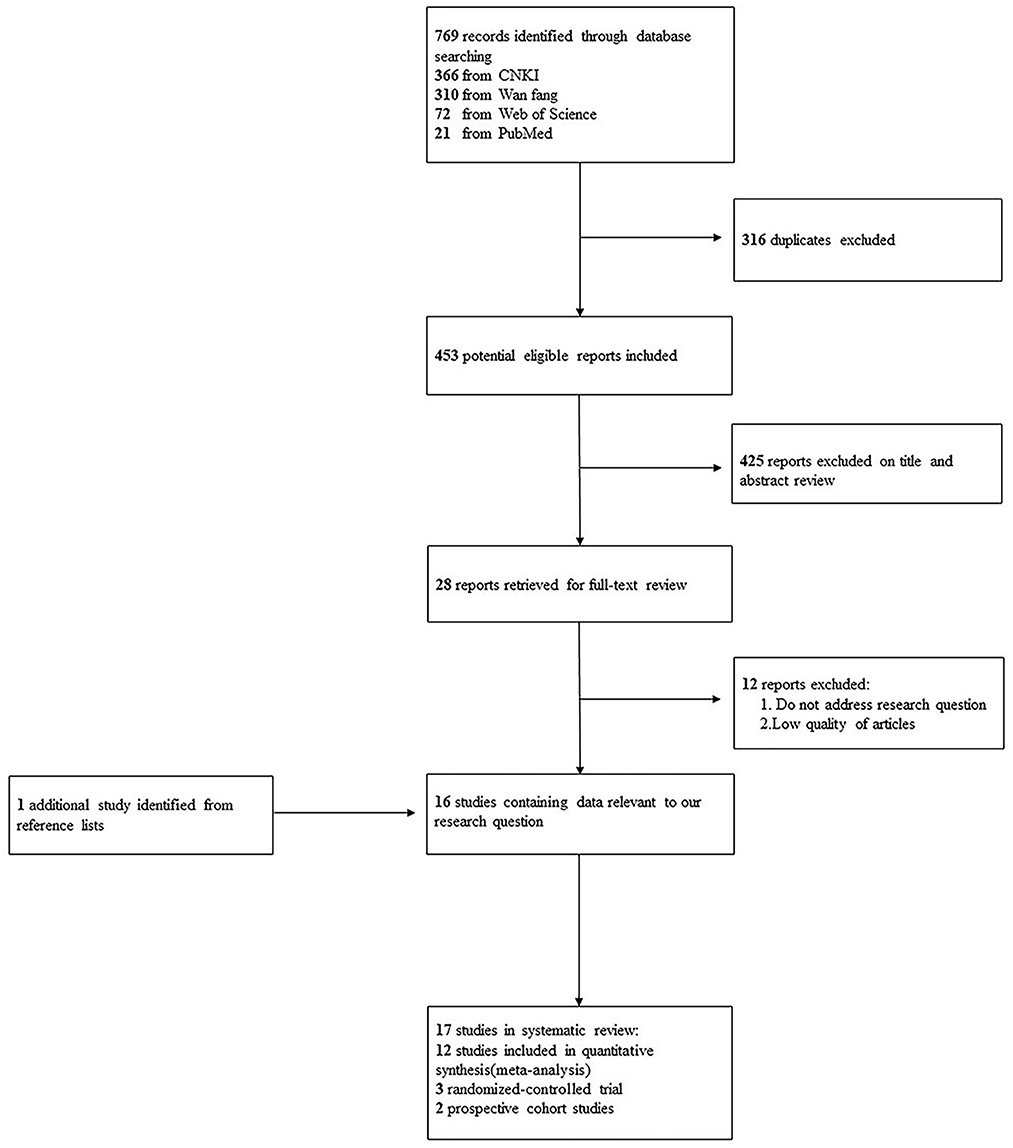
Figure 1. Flow diagram outlining the selection process for the inclusion of studies in the systematic review and meta-analysis.
Characteristics of the 12 studies (15, 22, 26–36) included in the meta-analysis, such as the name of the first author, year of publication, basic information of study population (numbers and crowds), region, the prevalence of myopia, definition of myopia, odds ratios (ORs), and 95% CIs for myopia are summarized in Table 1. A total of 80,364 people were involved in the univariate analysis and 109,744 people were involved in the multivariate study. There were six studies with more than 2,000 participants, accounting for 50% of the total included literature. Seven studies were from Chinese databases, and five studies were from English databases. The studies estimated the prevalence of myopia in a wide range from 40.2 to 86.8%. All studies gave the response rate and described the sampling method, although the degree was different.
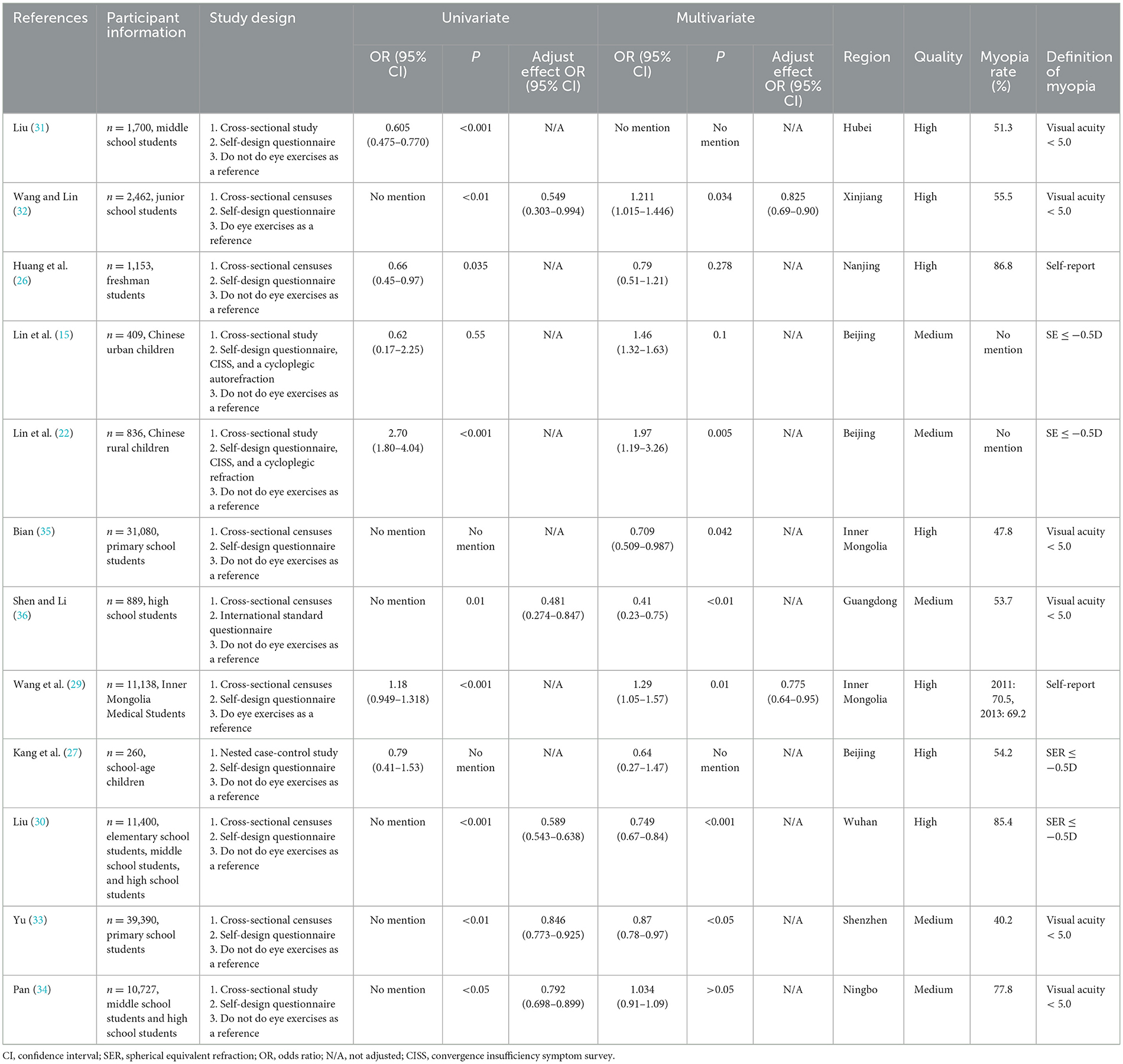
Table 1. Characteristics of the 12 studies included in the meta-analysis of eye exercises and myopia.
The heterogeneity test was carried out for these 12 studies, and there was obvious heterogeneity between the univariate and multivariate analyses. A univariate (I2 = 87.7%; Pheterogeneity = 0.000), multifactorial (I2 = 89.7%; Pheterogeneity = 0.000) random-effect model was used to combine the results. Pooled estimates are shown in Figure 2 and Supplementary Figure S1. In the univariate analysis, the random-effect meta-analysis showed that the pooled OR of myopia was 0.76 (95% CI: 0.62–0.89), and in the multivariate analysis, the random-effect meta-analysis showed that the pooled OR of myopia was 0.87 (95% CI: 0.72–1.02).
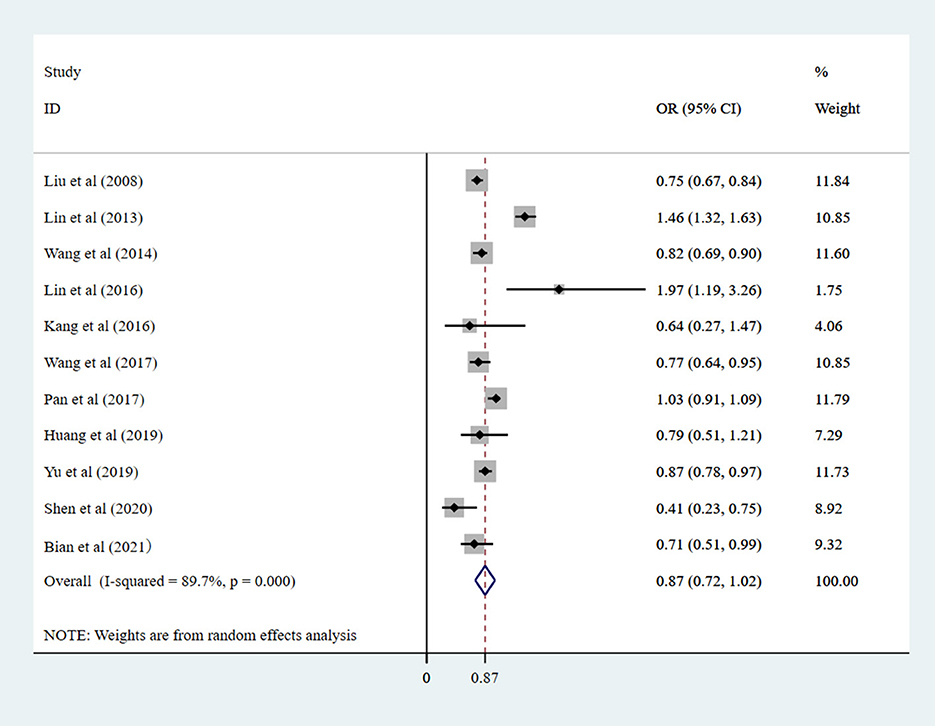
Figure 2. Randomized effect meta-analysis investigating the correlation between eye exercises and myopia in children and adolescents in multivariate analysis. CI, confidence interval; OR, odds ratio.
To investigate the source of heterogeneity, we used the published language, sample size (large sample: >2,000, small sample: ≤ 2,000), the definition of myopia, and quality as grouping variables in a prespecified subgroup analysis. The univariate analysis reveals that the heterogeneity of the language database subgroup and the quality subgroup has decreased slightly, indicating that the sources of heterogeneity may be the language database and the quality.
As shown in Supplementary Figure S2 and Figure 3, in the univariate analysis, there are five studies from English databases, and the pooled OR was 1.04 (95% CI: 0.61–1.48). There were six studies from Chinese databases, and the pooled OR was 0.67 (95% CI: 0.54–0.80). There is greater heterogeneity among the Chinese databases studies [I2 = 87.6% (Pheterogeneity = 0.000) vs. I2 = 80.1% (Pheterogeneity = 0.000)]. In the multivariate analysis, there were five studies from English databases, and the pooled OR was 1.05 (95% CI: 0.62–1.48), and six studies from Chinese databases, and the pooled OR was 0.80 (95% CI: 0.67–0.93). There is greater heterogeneity among the English databases studies [I2 = 91.2% (Pheterogeneity = 0.000) vs. I2 = 85.5% (Pheterogeneity = 0.000)]. Chinese databases show that Chinese eye exercises had a protective modest effect on myopic control.
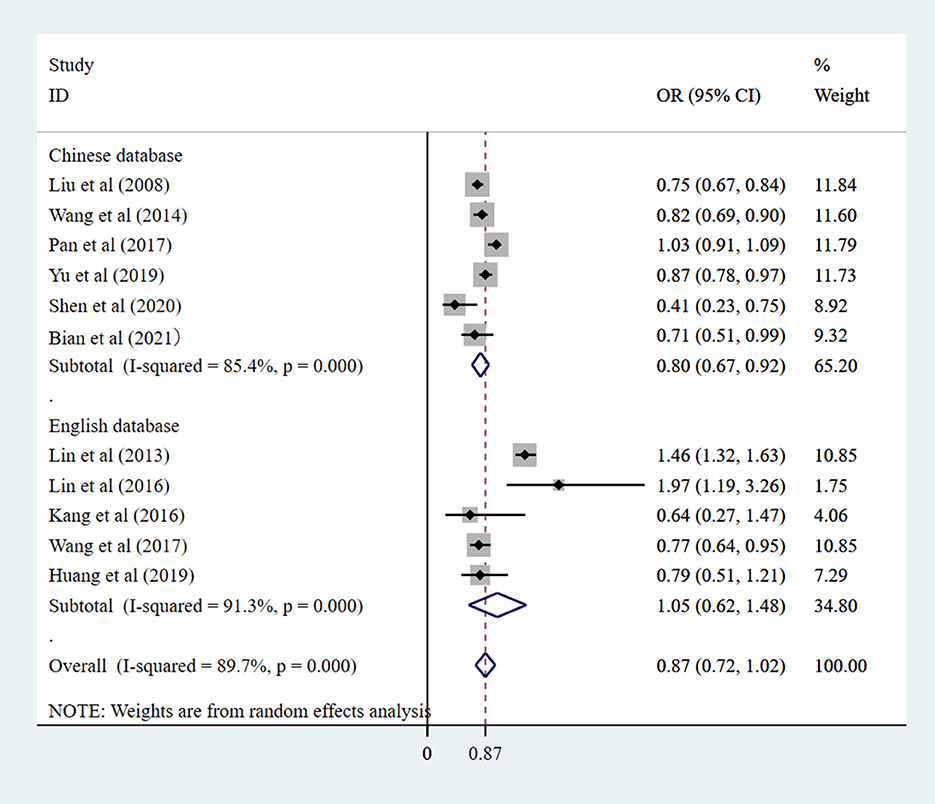
Figure 3. Language database subgroup of the studies on the correlation between eye exercises and myopia in children and adolescents in multivariate analysis.
As shown in Figure 4 and Supplementary Figure S3, in the univariate analysis, there were five large sample studies with a pooled OR of 0.80 (95% CI: 0.62–0.98). There were six studies of the small sample, with a pooled OR of 0.71 (95% CI: 0.45–0.97). There was greater heterogeneity among large sample studies [I2 = 93.9% (Pheterogeneity = 0.000) vs. I2 = 65.9% (Pheterogeneity = 0.012)]. In the multivariate analysis, there were six large sample studies with a pooled OR of 0.84 (95% CI: 0.74–0.94) and five small sample studies with a pooled OR of 0.99 (95% CI: 0.42–1.55). There was also a greater heterogeneity among small sample studies [I2 = 92.8% (Pheterogeneity = 0.000) vs. I2 = 79.5% (Pheterogeneity = 0.000). Large sample studies show that Chinese eye exercises have a protective effect on myopic control.
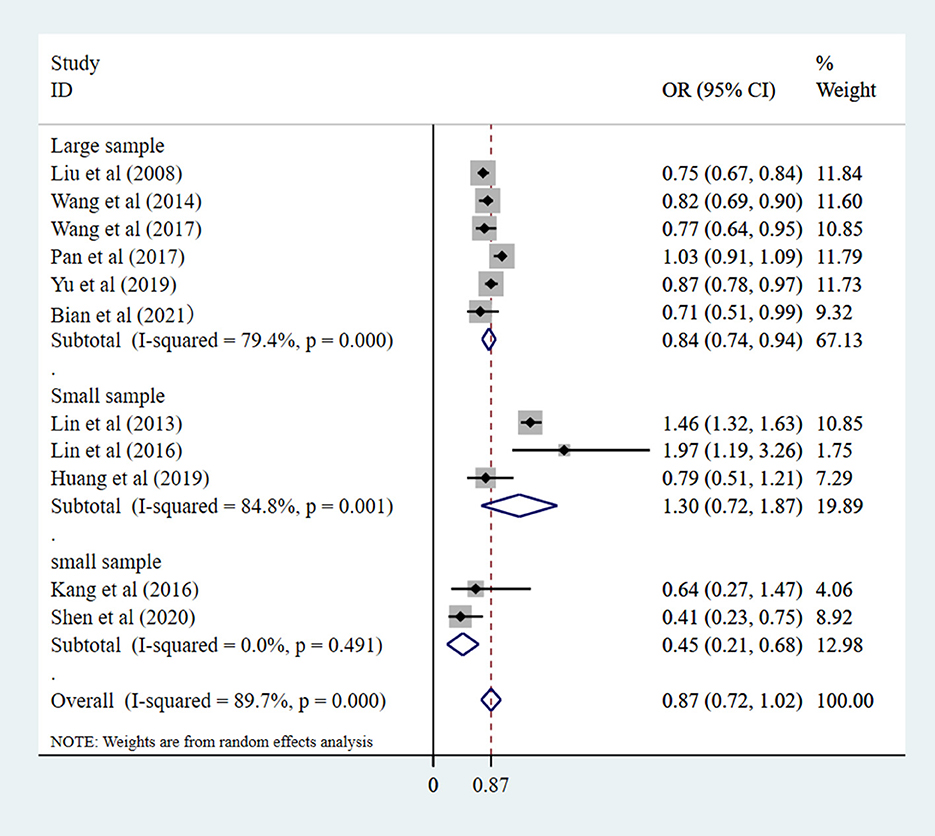
Figure 4. Sample size subgroup of the studies correlation between eye exercises and myopia in children and adolescents in multivariate analysis.
As shown in Supplementary Figures S4, S5, in the univariate analysis, four studies define myopia as SER ≤ −0.5D [I2 = 78.7% (Pheterogeneity = 0.003)], and the pooled OR was 1.01 (95% CI: 0.37–1.66). In total, five studies define myopia as visual acuity < 5.0 [I2 = 71.9% (Pheterogeneity = 0.007)], and the pooled OR was 0.71 (95% CI: 0.58–0.83). In total, two studies define myopia as a self-report [I2 = 90.2% (Pheterogeneity = 0.001)], and the pooled OR was 0.93 (95% CI: 0.42–1.44). In the multivariate analysis, four studies define myopia as SER ≤ −0.5D [I2 = 95.5% (Pheterogeneity = 0.000)], and the pooled OR was 1.12 (95% CI: 0.58–1.66). In total, five studies define myopia as visual acuity < 5.0 [I2 = 85.2% (Pheterogeneity = 0.000)], and the pooled OR was 0.80 (95% CI: 0.65–0.96). In total, two studies define myopia as a self-report [I2 = 0.00% (Pheterogeneity = 0.918)], and the pooled OR was 0.77 (95% CI: 0.63–0.92).
As shown in Supplementary Figures S6, S7, in the univariate analysis, six studies were of high quality [I2 = 86.7% (Pheterogeneity = 0.000)], and the pooled OR was 0.73 (95% CI: 0.52–0.93). The five studies were of medium quality [I2 = 76.6% (Pheterogeneity = 0.002)], and the pooled OR was 0.79 (95% CI: 0.60–0.98). In the multivariate analysis, six studies were of high quality [I2 = 0.00% (Pheterogeneity = 0.908)], and the pooled OR was 0.77 (95% CI: 0.71–0.83). The five studies were of medium quality [I2 = 93.8% (Pheterogeneity = 0.000)], and the pooled OR was 1.02 (95% CI: 0.73–1.30).
To explore the source of heterogeneity, sensitivity analysis was conducted for the studies, and the included single studies were successively removed item by item. The results of the univariate analysis are shown in Supplementary Figure S8, and the results of the multivariate analysis are shown in Figure 5. Consistent with the original analysis results, single studies have little influence on the combined results, indicating that the combined effect value of this study is relatively stable.
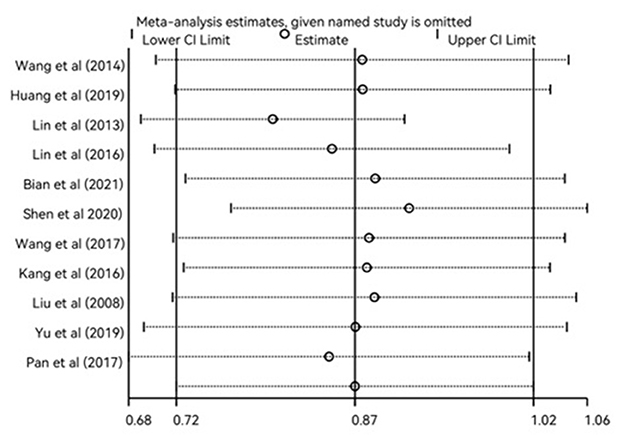
Figure 5. Sensitivity analysis of the relationship between eye exercises and myopia in children and adolescents in multivariate analysis.
As shown in Figure 6 and Supplementary Figure S9, we assessed for publication bias in the 12 studies with a funnel plot; there are some signs of asymmetry in the figure, and the asymmetry in the distribution of studies contained in funnel plots may be due to publication bias, heterogeneity of effect sizes between studies or by chance. In univariate analysis, neither Begg's (z = 0.47, P = 0.64) nor Egger's (t = 1.52, P = 0.16) tests indicated publication bias in 11 studies. In the multivariate analysis, neither Begg's (z = 0.00, P = 1.00) nor Egger's (t = 0.52, P = 0.61) tests show any obvious publication bias (the results of Begg's and Egger's tests are primarily dependent on the P-value, and P < 0.05 is generally considered to be publication bias).
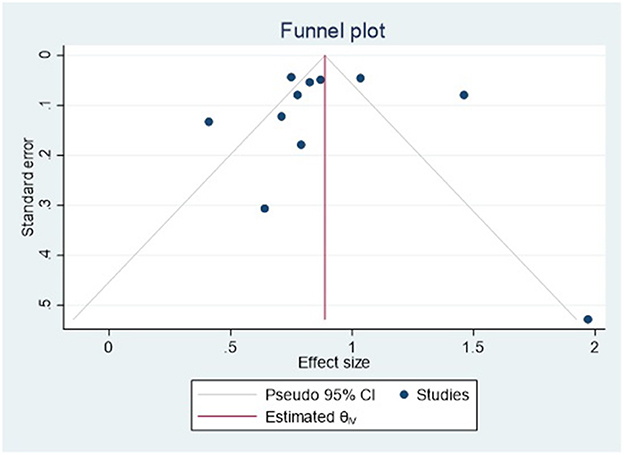
Figure 6. Publication bias funnel diagram of studies on the relationship between eye exercises and myopia in children and adolescents in multivariate analysis.
Data from five studies involving 22,457 children were not available for meta-analysis (Table 2). The five studies investigated the relationship between eye exercises and myopia control (two prospective cohorts; three RCTs). Zhang et al. performed an RCT in China in which 405 students were in the same learning environment (20). They were divided into two groups according to whether they seriously performed eye exercises and analysis of the two groups of vision changes. The results showed that the attitude toward eye exercises had a significant impact on vision; unconscientiousness was associated with vision loss, P < 0.05, and RR was 2.41. Li et al. performed an RCT that enrolled 195 seventh graders and excluded five participants (three with a history of eye trauma and two with other interventions). They found that Chinese eye exercises temporarily relieved children's accommodative lag statistically, but it may not be clinically significant (16). The use of an instrumental variable method and bivariate probability method revealed the adverse effects of regular Chinese eye exercises on students' vision. Students who exercised regularly were 6.2 percentage points more likely to have vision impairment and 7.6% points more likely to be nearsighted than students who did not exercise regularly (19). The two cohort studies were followed at 9 months, 21 months, and 3 years. Wang et al. found no evidence that eye exercises had any effect on vision (18). Liang et al. found that Chinese eye exercises were effective in reducing myopia progression in urban Chinese students aged 6–17 years (17).
This systematic review and meta-analysis aimed to summarize all available pieces of evidence on the relationship between eye exercises and myopia control. A more comprehensive quantitative analysis of the association between eye exercises and myopia in children and adolescents was performed by meta-analysis, and the results of independent studies were statistically combined, taking into account the consistency of the data. Among the 17 included studies, a sample of 134,201 people was used for analysis, and 12 univariate and multivariate analyses were conducted. The results showed that if age, gender, and other factors were not considered, there would be a negative correlation between performing eye exercises and myopia. In other words, the probability of myopia decreased by 24% when eye exercises were done. If other variables were considered, there was no significance between doing eye exercises and controlling myopia. However, subgroup analyses of large samples and Chinese databases showed a moderate protective effect of Chinese eye exercises on myopia in multivariate analyses. This evidence suggests that eye exercises are effective in controlling myopia in large population studies.
Publication bias is a well-known flaw in meta-analysis methodology. The results of the subgroup analysis are not significant. The funnel chart shows some signs of asymmetry, which could be due to publication bias, heterogeneity, or the contingency of inter-study effects. However, due to the high representativeness of the sample, most studies control for confounding factors such as age, gender, and parental myopia, resulting in higher research quality in meta-analysis. Simultaneously, the qualitative sensitivity analysis of the included research reveals that the overall effect value is relatively stable. Furthermore, both Begg's and Egger's tests showed no significant publication bias.
The differences in the results of the multivariate analysis may be caused by the insufficient sample size and the non-standard attitude toward eye exercises. Most Chinese students only need to perform eye exercises one or two times a day for 5 min at school. Generally speaking, the time for eye exercises for Chinese children is very short. Moreover, most children and adolescents are unable to perform standard Chinese eye exercises. Previous research has shown that ~90% of Chinese children do not perform eye exercises correctly. Although they perform eye exercises every day, most of them cannot find the accurate acupoints around the eye, and there are no accurate pressure methods and manipulation skills (18, 37). Studies have shown that, compared with people who do not perform eye exercises regularly, people who perform eye exercises regularly have a 6.2% increase in the probability of vision damage and a 7.6% increase in the probability of myopia. Assuming that Chinese eye exercises are effective in protecting children's vision when used correctly (or at least do not pose a significant threat to children's visual health), we found that adverse effects may be caused by students performing eye exercises incorrectly (19). In addition, existing studies have proved that careful practice of correct eye exercises can make students take the initiative to rest the tired muscles with regular acupuncture points around their eyes (18, 37). Rhythmic massage can improve blood circulation in the eyes, accelerate muscle relaxation, enable blood vessels, nerves, and muscles to exert better physiological functions, gradually restore vision, and prevent vision loss (38). Therefore, children and adolescents should be encouraged to perform high-quality Chinese eye exercises. In addition, the protective effect of eye exercises on myopia may be related to better eye health awareness in children and adolescents who performed eye exercises. Kang et al. (27) conducted a 2-year study on 201 seventh-grade students and showed that students who can complete eye exercises with high quality have 0.15 D less myopia than other students. This may be because students who can correctly and conscientiously complete eye exercises are often able to pay more attention to eye protection, thus making it easier to develop good eye habits in life. As the Chinese government has been popularizing scientific ophthalmology knowledge and improving the eye health of children and adolescents, children's awareness of eye health has also been improved. They performed eye exercises with a serious attitude, and the protective effect of eye exercises was highly significant. Therefore, it is necessary for relevant departments and schools to further improve and strengthen the completion quality of eye exercises and improve the professionalism and responsibility of teachers and parents. Adhering to the scientific principle to continuously evaluate and optimize eye exercises, at the same time, we must fully implement policy intervention, pay equal attention to eye exercises and health education, form a multi-party linkage of “government-school-family,” and establish a scientific and effective myopia prevention and control system.
More definitive answers need to be provided by sufficiently reliable controlled trials. Given the widespread use of eye exercises in schools across China and existing policy practices supported by the Chinese government, it is unclear whether such research would be supported outside of China. A previous study (n = 190) reported that there is a statistical but not clinical significance between correct eye exercises and reduced accommodative lag in children (16). Accommodative lag is defined as the difference between accommodative demand and accommodative response, which may be related to myopia (39).
There are some shortcomings in the existing research on the relationship between eye exercises and myopia. (1) The reliability and validity of self-designed questionnaires are inconsistent. (2) Most of the current research focuses on the generalization of the relationship between eye exercises and myopia in children and adolescents. However, there is no research on whether there are differences in the relationship between eye exercises and myopia among different genders (boys and girls) and grades (primary school, junior high school, and senior high school). In addition, there is less research on the difference between eye exercises and myopia at different times and periods, and it is worth exploring further. (3) In the measurement of indexes, some studies did not conduct ciliary muscle paralysis before measuring myopia, which may overestimate the number of children and adolescents with myopia. Moreover, the collection of data on eye exercise performance by questionnaire could cause recall bias.
There are also some limitations in this review. (1) Literature retrieval is limited to English and Chinese, which may lead to language or cultural bias. (2) The prevalence of myopia in children and adolescents is highly heterogeneous, and the findings need to be validated with more high-quality studies. (3) Data were obtained from published literature, and some studies lacked extractable data, which limited the number of studies included in the meta-analysis. (4) These studies span a wide range of years and may have some influence on the results. All these limitations need to be filled by further research and exploration.
Meta-analysis proves that Chinese eye exercises are effective in controlling myopia, but more high-quality studies, especially intervention studies, are needed to verify the reliability of the results. According to the results of this review, the prevention and control of myopia among children and adolescents need the joint participation of the government, schools, families, and students. In terms of suggestions, the government should improve the rules and regulations of myopia prevention and control, carry out quality education, and create a good learning atmosphere for students. Chinese schools should try their best to correct students' performance of Chinese eye exercises; neglecting hand hygiene can lead to conjunctivitis, and guidance on standard procedures should also be promoted, together with the school rules regarding eye exercises, for example, we should provide more guidance and instructions on how to do these exercises correctly and closely monitor students' performance. Students should improve their awareness of the severity of myopia, allocate their time reasonably, be skilled in the operation of acupoints, and take eye exercises seriously.
The original contributions presented in the study are included in the article/Supplementary material, further inquiries can be directed to the corresponding authors.
WW was involved in conceptualization and methodology. JT and YP participated in data curation and writing the original draft. JW, NY, YL, and WZ supervised and validated the study. WW and XW participated in writing, reviewing, and editing. All authors contributed to the article and approved the submitted version.
This study was supported by the Project Source Science and Technology Development of Clinical Medicine of Jiangsu University in 2021, JLY2021179, XW, Science and Technology Project of Xuzhou, KC21278, XW, Xuzhou Medical Leading Talent Training Project, XWRCHT20210022, XW, and Development Fund of the Affiliated Hospital of Xuzhou Medical University, XYFM2021038, XW.
The authors declare that the research was conducted in the absence of any commercial or financial relationships that could be construed as a potential conflict of interest.
All claims expressed in this article are solely those of the authors and do not necessarily represent those of their affiliated organizations, or those of the publisher, the editors and the reviewers. Any product that may be evaluated in this article, or claim that may be made by its manufacturer, is not guaranteed or endorsed by the publisher.
The Supplementary Material for this article can be found online at: https://www.frontiersin.org/articles/10.3389/fpubh.2023.950700/full#supplementary-material
1. Ramakrishnan MS, Gilbert AL. Telemedicine in neuro-ophthalmology. Curr Opin Ophthalmol. (2021) 32:499–503. doi: 10.1097/ICU.0000000000000800
2. Alvarez-Peregrina C, Martinez-Perez C, Villa-Collar C, González-Pérez M, González-Abad A, Sánchez-Tena M, et al. The prevalence of myopia in children in Spain: an updated study in 2020. Int J Environ Res Public Health. (2021) 18:12375. doi: 10.3390/ijerph182312375
3. Pruett RC. Complications associated with posterior staphyloma. Curr Opin Ophthalmol. (1998) 9:16–22. doi: 10.1097/00055735-199806000-00004
4. Saw SM, Gazzard G, Shih-Yen EC, Chua WH. Myopia and associated pathological complications. Ophthalmic Physiol Opt. (2005) 25:381–91. doi: 10.1111/j.1475-1313.2005.00298.x
5. Saw SM. How blinding is pathological myopia? Br J Ophthalmol. (2006) 90:525–6. doi: 10.1136/bjo.2005.087999
6. Chen M, Wu A, Zhang L, Wang W, Chen X, Yu X, et al. The increasing prevalence of myopia and high myopia among high school students in Fenghua city, eastern China: a 15-year population-based survey. BMC Ophthalmol. (2018) 18:159. doi: 10.1186/s12886-018-0829-8
7. Li Y, Liu J, Qi P. The increasing prevalence of myopia in junior high school students in the Haidian District of Beijing, China: a 10-year population-based survey. BMC Ophthalmol. (2017) 17:88. doi: 10.1186/s12886-017-0483-6
8. Ostberg O, Horie Y, Feng Y. On the merits of ancient Chinese eye acupressure practices. Appl Ergon. (1992) 23:343–8. doi: 10.1016/0003-6870(92)90296-8
9. Tian FF, Liu LJ, Guo Y, Wang S, Tian X, Tian QY, et al. Effects of eye exercises on axial eye elongation in junior students. Zhonghua Liu Xing Bing Xue Za Zhi. (2021) 42:1621–7. doi: 10.3760/cma.j.cn112338-20201118-01338
10. Zhao J, Pan X, Sui R, Munoz SR, Sperduto RD, Ellwein LB. Refractive error study in children: results from Shunyi District, China. Am J Ophthalmol. (2000) 129:427–35. doi: 10.1016/S0002-9394(99)00452-3
11. He M, Zheng Y, Xiang F. Prevalence of myopia in urban and rural children in mainland China. Optom Vis Sci. (2009) 86:40–4. doi: 10.1097/OPX.0b013e3181940719
12. Wei ML, Liu JP, Li N, Liu M. Acupuncture for slowing the progression of myopia in children and adolescents. Cochrane Database Syst Rev. (2011) 9:Cd007842. doi: 10.1002/14651858.CD007842.pub2
13. Zhu Z, Chen Y, Tan Z, Xiong R, McGuinness MB, Müller A. Interventions recommended for myopia prevention and control among children and adolescents in China: a systematic review. Br J Ophthalmol. (2021) 107:160–6. doi: 10.1136/bjophthalmol-2021-319306
14. Pan De Y R, Aranha VP, Samuel AJ, Kumar SP. A scoping literature review on effects of eye exercises for myopia in children. Physiother Occup Ther J. (2015) 8:27–9. doi: 10.21088/potj.0974.5777.8115.4
15. Lin Z, Vasudevan B, Jhanji V, Gao TY, Wang NL, Wang Q, et al. Eye exercises of acupoints: their impact on refractive error and visual symptoms in Chinese urban children. BMC Complement Altern Med. (2013) 13:306. doi: 10.1186/1472-6882-13-306
16. Li SM, Kang MT, Peng XX, Li SY, Wang Y, Li L, et al. Efficacy of Chinese eye exercises on reducing accommodative lag in school-aged children: a randomized controlled trial. PLoS ONE. (2015) 10:e0117552. doi: 10.1371/journal.pone.0117552
17. Liang YB, Vasudevan B, Lin Z, Zhou HJ, Ciuffreda KJ. The effect of eye exercises of acupoints on myopia progression: a 3-year cohort report from the Beijing myopia progression study. Risk Manag Healthc Policy. (2020) 13:2793–9. doi: 10.2147/RMHP.S281289
18. Wang H, Qian Y, Congdon N, Boswell M, Rozelle S, Ma X. Effect of Chinese eye exercises on change in visual acuity and eyeglasses wear among school-aged children in rural China: a propensity-score-matched cohort study. BMC Complement Med Ther. (2020) 20:82. doi: 10.1186/s12906-020-2878-9
19. Huang J, Chen Q, Du K, Guan H. Does performing the chinese eye exercises help protect children's vision? - New evidence from primary schools in rural northwestern China. Risk Manag Healthc Policy. (2020) 13:2425–38. doi: 10.2147/RMHP.S277917
20. Zhang DL, Tang H. Study on the effect of attitude to eye exercise on vision. Chinese J School Doctor. (2006) 20:501–3. doi: 10.3969/j.issn.1001-7062.2006.05.024
21. Downs SH, Black N. The feasibility of creating a checklist for the assessment of the methodological quality both of randomised and non-randomised studies of health care interventions. J Epidemiol Community Health. (1998) 52:377–84. doi: 10.1136/jech.52.6.377
22. Lin Z, Vasudevan B, Fang SJ, Jhanji V, Mao GY, Han W, et al. Eye exercises of acupoints: their impact on myopia and visual symptoms in Chinese rural children. BMC Complement Altern Med. (2016) 16:349. doi: 10.1186/s12906-016-1289-4
23. Shim SR, Shin IS, Bae JM. Intervention meta-analysis using STATA software. J Health Inform Stat. (2016) 41:123–34. doi: 10.21032/jhis.2016.41.1.123
24. Thompson SG, Sharp SJ. Explaining heterogeneity in meta-analysis: a comparison of methods. Controlled Clinical Trials. (1999) 18:2693. doi: 10.1002/(SICI)1097-0258(19991030)18:20<2693::AID-SIM235>3.0.CO
25. Viechtbauer W. Publication bias in meta-analysis: prevention, assessment and adjustments. Psychometrika. (2007) 72:269–71. doi: 10.1007/s11336-006-1450-y
26. Huang L, Kawasaki H, Liu Y, Wang Z. The prevalence of myopia and the factors associated with it among university students in Nanjing: a cross-sectional study. Medicine. (2019) 98:e14777. doi: 10.1097/MD.0000000000014777
27. Kang MT, Li SM, Peng X, Li L, Ran A, Meng B, et al. Chinese eye exercises and myopia development in school age children: a nested case-control study. Sci Rep. (2016) 6:28531. doi: 10.1038/srep28531
28. Xie HL, Xie ZK, Zhou F, Hu L. Myopia prevalence and influencing factor analysis of primary and middle school students in our country. Zhonghua Yi Xue Za Zhi. (2013) 93:999–1002. doi: 10.3760/cma.j.issn.0376-2491.2013.13.012
29. Wang L, Du M, Yi H, Duan S, Guo W, Qin P, et al. Prevalence of and factors associated with myopia in inner mongolia medical students in china, a cross-sectional study. BMC Ophthalmol. (2017) 17:52. doi: 10.1186/s12886-017-0446-y
30. Liu JQ. Study on status and influencing factors of low vision among primary and middle school students in Wuhan (Master thesis). Huazhong University of Science and Technology, Wuhan, China. (2008).
31. Liu CJ. A survey on prevalene of myopia and its influencing factors on middle school students. Modern Prevent Med. (2010) 37:3047–3048+3051.
32. Wang TT, Lin Y. Prevalence and risk factor of myopia among Uygur and Han junior school students in Urumqi. Chinese J School Hwalth. (2014) 35:877–80. doi: 10.16835/j.cnki.1000-9817.2014.06.027
33. Yu JL. Analysis of risk factors and intervention effect of poor vision among primary school students in Baoan District, Shenzhen. Pract Prevent Med. (2019) 26:1365–8.
34. Pan GL. Analysis of the current situation and influencing factors of myopia among adolescents in Ningbo. Modern Pract Med. (2017) 29:202–5. doi: 10.3969/j.issn.1671-0800.2017.02.034
35. Bian HX. Investigation on the current situation of myopia among pupils in Baotou City and analysis of related factors. Int Eye Sci. (2021) 21:1834–8. doi: 10.3980/j.issn.1672-5123.2021.10.35
36. Shen DY, Li XH. Influencing factors of myopia among primary and secondary school students in Shenzhen. Chinese J School Health. (2020) 41:583–7. doi: 10.16835/j.cnki.1000-9817.2020.04.027
37. Rawstron JA, Burley CD, Elder MJ. A systematic review of the applicability and efficacy of eye exercises. J Pediatr Ophthalmol Strabismus. (2005) 42:82–8. doi: 10.3928/01913913-20050301-02
38. Crisp WH. More about eye exercises. Am J Ophthalmol. (1943) 26:872–6. doi: 10.1016/S0002-9394(43)91015-3
Keywords: myopia, Chinese, eye exercises, adolescents, meta-analysis
Citation: Tang J, Pei Y, Wang J, Yan N, Luo Y, Zhou W, Wang X and Wang W (2023) The association between Chinese eye exercises and myopia in children and adolescents: A systematic review and meta-analysis. Front. Public Health 11:950700. doi: 10.3389/fpubh.2023.950700
Received: 23 May 2022; Accepted: 10 February 2023;
Published: 10 March 2023.
Edited by:
Shi Song Rong, Massachusetts Eye and Ear Infirmary and Harvard Medical School, United StatesReviewed by:
Mengtian Kang, Beijing Tongren Hospital, Capital Medical University, ChinaCopyright © 2023 Tang, Pei, Wang, Yan, Luo, Zhou, Wang and Wang. This is an open-access article distributed under the terms of the Creative Commons Attribution License (CC BY). The use, distribution or reproduction in other forums is permitted, provided the original author(s) and the copyright owner(s) are credited and that the original publication in this journal is cited, in accordance with accepted academic practice. No use, distribution or reproduction is permitted which does not comply with these terms.
*Correspondence: Wei Wang, d2Vpd2FuZzkwQDE2My5jb20=; Xiaojuan Wang, MTUzODAzNDY4QHFxLmNvbQ==
†These authors have contributed equally to this work and share first authorship
Disclaimer: All claims expressed in this article are solely those of the authors and do not necessarily represent those of their affiliated organizations, or those of the publisher, the editors and the reviewers. Any product that may be evaluated in this article or claim that may be made by its manufacturer is not guaranteed or endorsed by the publisher.
Research integrity at Frontiers

Learn more about the work of our research integrity team to safeguard the quality of each article we publish.